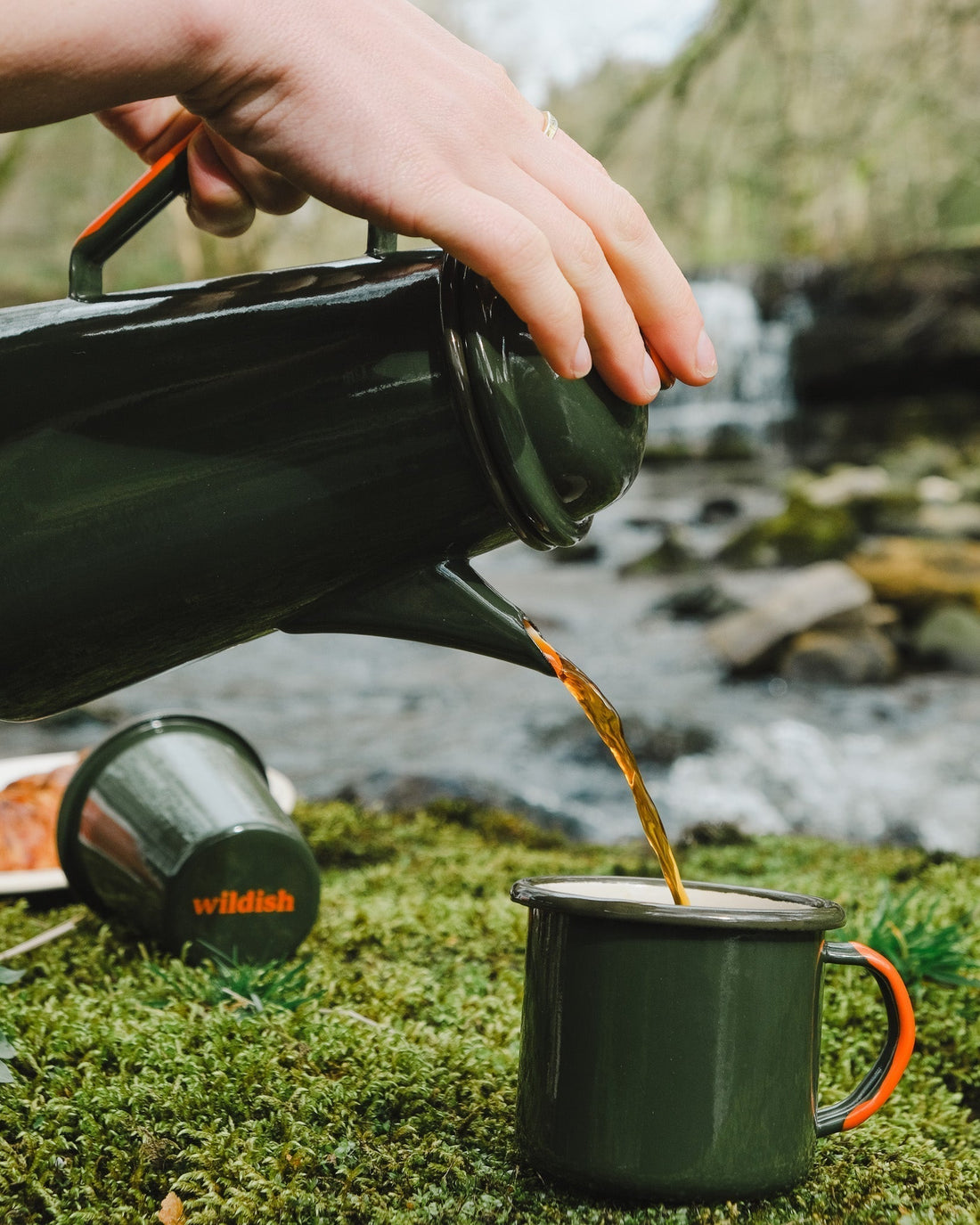
The best outdoor coffee? It’s made in an enamel coffee pot.
Share
The best outdoor coffee? It’s made in an enamel coffee pot.
Functional, stylish and practically indestructible, enamel mugs, plates and coffee pots are easy to clean, durable and non-reactive. They’ve been ubiquitous in the camping world for decades. They’re also making a bit of a comeback, both in our kitchens and with outdoor enthusiasts. Join us as we delve into the history of enamelware, and why we chose enamel for our outdoor coffee line.

The history of enamel coffee pots
Enamelware dates back to the 18th century, when it emerged as a practical solution in kitchens all over Europe. It can in fact be traced back to Germany in 1760, but it wasn’t until the early 1800s that it became more widespread.The enamel coating made pots more resistant to rust, and less likely to leech harmful substances into food. By the 1850s, enamel was more common, particularly when it came to coffee utensils, and by the end of the century could be found in many households.
By the mid-1900s, enamel utensils had evolved from utilitarian kitchen tools to decorative and nostalgic items and, thanks to their durability, became increasingly popular to use when picnicking, hiking and camping.
Why does enamel make great coffee?
One of the great advantages of enamel coffee pots is their excellent heat retention properties. The enamel coating allows for even heat distribution, ensuring that your coffee brews uniformly, which is essential for extracting rich flavours from the coffee grounds. This is particularly beneficial for those who enjoy a strong, full-bodied cup of coffee. The ability to maintain consistent temperatures throughout the brewing process, especially when outside, can lead to a more flavourful and aromatic brew.

Additionally, enamel coffee pots are remarkably durable and resistant to wear and tear. Unlike glass or ceramic, enamel-coated pots are less prone to chipping and cracking, making them ideal for daily use. They’re light, can be easily thrown into a bag or backpack (like our Pateley Tote or Gouthwaite 13-15L), and enamel pots and mugs can be placed directly on top of a campfire or stove - no need for extra pots or pans!
They also keep your coffee warmer for longer, compared to their stainless steel or plastic counterparts.
Choosing an enamel coffee pot
Enamel coffee pots come in all shapes and sizes, typically ranging from small one-cup pots to larger ones that can brew up to twelve cups at a time. If you camp or hike in big groups, or if you just drink a lot of coffee, a larger pot might be better. Smaller pots are fine too! Our coffee pot fits around 5 small cups of coffee.
The quality of the enamel coating and the pot's construction are super important too. A well-made enamel coffee pot should have a smooth, even coating that is free from imperfections, a sturdy handle and a lid that fits snugly to retain heat during brewing. Our coffee pot perfectly fits a V60 dripper for pour-over coffees. We also found out (by accident) that the lid perfectly fits our enamel mugs too.

Where are enamel coffee pots manufactured?
Enamel is manufactured all over the world. The UK used to be one of the leading producers of enamelware, with the iconic white-with-navy-trim appearing in kitchens and camp kits all over the country. Falcon still designs great enamel homeware although its no longer made in the UK. Despite its long history, we struggled to find any enamelware manufacturers that still produce it in the UK - most are now made in China or South East Asia, and all the examples we found felt flimsier than we wanted.
So we looked further afield to Europe, and found a fantastic Polish manufacturer. They produce enamelware to our specifications from certified components, including steel. The enamel itself is one of the most food-safe cooking materials you can find!

How to look after your enamel coffee pot
If you look after it, your enamel coffee pot will last forever. After each use, gently wash the pot with warm, soapy water and a soft sponge. Avoid abrasive cleaners or scrubbers, as they can scratch the enamel surface. Rinsing thoroughly and drying the pot immediately after cleaning will help prevent water spots and keep it looking pristine.
To preserve the enamel's longevity, it's advisable to avoid drastic temperature changes. For instance, do not place a hot pot directly into cold water, as this can cause the enamel to crack. Instead, allow the pot to cool down gradually before washing. When using the pot on the stovetop, opt for low to medium heat to prevent overheating, which can lead to damage over extended use.
Conclusion
Our enamel coffee pots reflect our brand ethos; we want to make simple things that last forever to help you have fun outside, whilst reducing our impact on the planet. Shop our coffee and enamel range here, and check out our bags and accessories too.
